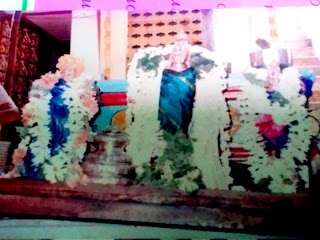BAHULA PANCHAMI
The Heading denotes the fifth day of the waning moon when the great soul Saint Thyagaraja attained Jeevan Mukthi in the tamil month of Thai and his mortal remains were interred on the banks of the five rivers and the place called Thiruvaiyaru.
(Here I want to convey something about Saint Tyagaraja, also known as Tyagayya in Telugu, was one of the greatest composers of Carnatic music or Indian classical music. He was a prolific composer and highly influential in the development of the classical music tradition. Tyagaraja composed thousands of devotional compositions, most in praise of Lord Rama, many of which remain popular today. Of special mention are five of his compositions called the Pancharatna Kritis which was even a base for carnatic music.)
The day of his Nirayana is considered to be auspicious that it looks as though Thyagaraja chose to shed his mortal coil on that day.
The verdant paddy fields with wavelike undulations having a backdrop of sylvan surroundings add charm to the holy place. the cool ozone wafts through the divine air that is pervading already brings an inexplicable ecstasy and subliminal tranquility to every pious person.
Although Thyagaraja was born at Thiruvarur his parents migrated to this place obviously feeling it to be conducive for divine pursuits. During ordinary days an strange atmosphere permeates in and around the "Sannithi" to the rustle of the leaves of trees around. The place reverberates with animation only during this annual festival when there is an influx of musicians which term embraces the vocalists, violinists, vainikas, flutists, and those who play percussion instruments. They throng on the day of "Bahula Panchami" at the special pandal in front of the "Sammadhi" in their traditional dress with caste marks on their forehead thus producing a divine auras to the congregation.
This annual festival is celebrated for five days obviously conforming to the fifth day viz., Panchami the name of the Kshetra and Pancharatna that is being sung with rapture. It starts with "Uncha Vritti" Bhajan circumambulating the streets starting from the residence of the great saint at "Thirumanjana Veedi". To the chanting of the Vedhas "Thirumanjanam" is performed as the day dawns on the "Panchami Thithi" to the heralding of the famous krithi of Thyagaraja as per established convention viz "Chetulara" in "Bhairavi" played on flute and on Nadaswaram while ripples on the cauvery gurgle synchronising with the mood. The concourse of people reverentially sit in the enclosures to witness the "Abishekam" and simultaneously hear the pancharatna kirtanas by eminent musicians to which even amateurs join with glee. The Cauvery slows down with placidity apparently to enjoy the concert which is available to it only once in a year.
The concerted singing supported by accompaniments with rhythm carries everyone to the realm of God and creates a sense of feeling of being in tune with the infinite at least for a while. The gems Jagadanandakaraka, Dudukukalanannae, Sadhinchane, Kanakana, and Entharomahanubhavulu in the ragam Nattai, Gowlai, Aarabi, Varali and Sriragam respectively sung in chorus rent the air and the duration is one hour to both the singers and the audience. At the conclusion of each song "Aarathi" is performed to the icon of the great composer who is decorated with flowers. The ethos of the traditional and customary practice pervades the entire atmosphere and is being preserved with piety and sanctity.
The music world is very much indebted to this great savant composer whose compositions are sung in all the music halls and auditoriums and are being heard with gusto both by connoisseurs and ordinary lovers of music.
After the event the place puts forth a void till the next year with a sepulchral silence and the Cauvery dawdle nonchalantly in its meandering course to put it in words of the poet Teenyson on "the Brook", "Men may come and men may go but I go on for ever"
Further readings :









